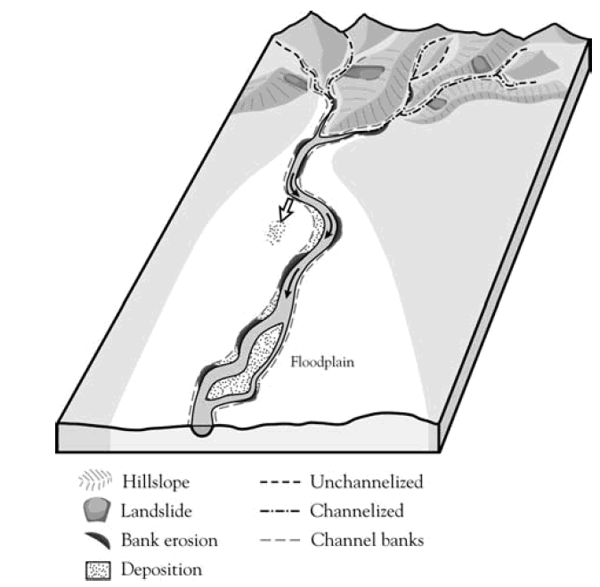2 River Dynamics and Erosion
Rivers are systems in dynamic equilibrium. It balances water flow and sediment transport. When river channels are altered under naturally dynamic hydrologic conditions, the river readjusts itself with respect to dimension, profile and pattern to reach its former balance or equilibrium (Couture, 2008). Free-flowing rivers tend to reach a state of equilibrium by a process of erosion and deposition. Erosion at one location is roughly balanced by deposition at another (CRJC, 1996). Diverse bank erosion processes occur throughout the river network starting from upper reach to lower reach. In the upper reach, near its source, the river has a huge amount of material to cut through to reach base level, so it primarily erodes downwards, creating a steep-sided v-shaped valley. In the middle reach the river continues to cut downwards but it is also starting to cut sideways or laterally. Once the river has reached the lower course (i.e., lower reach) and is nearing the sea, the river has almost reached its base level, so most of its erosive energy is concentrated on cutting laterally, creating features such as meanders.Figure 2* illustrates the occurrences of bank erosion along an idealised river network. The bank erosion process in several sections of the river network is influenced by the size of the channel, discharge, and flow strength (Florsheim et al., 2008*). So, bank erosion is an ongoing natural process. Even at rivers that are assumed to be stable, their well defined channels shift over a long period of time through the processes of erosion and sedimentation.
Figure 2: Bank erosion in different sections of an idealised river network. Image reproduced with
permission from Florsheim et al. (2008), copyright by OUP.





